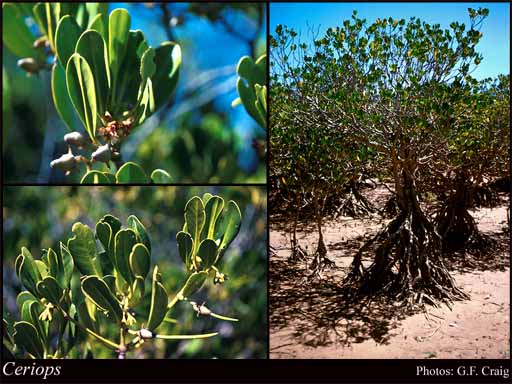- Reference
- Ann.Nat.Hist. p363 (1838)
- Name Status
- Current







Scientific Description
Common name. Mangroves. Family Rhizophoraceae.
Habit and leaf form. Trees, or shrubs. Leaves cauline. Helophytic (coastlines, estuaries and tidal swamps). Leaves opposite (crowded near the tips of shoots); leathery; petiolate; simple. Leaf blades entire; obovate (to broadly spathulate); pinnately veined (obscure on both surfaces). Leaves with stipules (interpetiolar). Stipules interpetiolar (sheathing the terminal bud); with colleters (secreting mucilage), or without colleters; caducous (leaves an annular scar). Leaf blade margins entire; revolute (slightly). Leaf anatomy. Hairs absent. Extra-floral nectaries absent. Stem anatomy. Secondary thickening developing from a conventional cambial ring. Roots. Aerial roots present (often clustered around the base of trunks, knee roots may also be present, often buttressed).
Reproductive type, pollination. Fertile flowers hermaphrodite. Unisexual flowers absent. Plants hermaphrodite. Plants viviparous.
Inflorescence and flower features. Flowers aggregated in ‘inflorescences’; in cymes (4-many flowered, dense). The terminal inflorescence unit cymose, or racemose. Inflorescences axillary. Flowers pedicellate; ebracteate; bracteolate (connate at base); regular; usually 4 merous, or 5 merous. Free hypanthium present; adnate to the ovary, very short, hidden by the bracteoles. Perianth with distinct calyx and corolla; 6–32; 2 -whorled; isomerous. Calyx present; 5–6 (usually 5); 1 -whorled; gamosepalous; blunt-lobed; valvate; tubular; regular; commonly fleshy (or leathery); persistent. Calyx lobes ovate (to narrowly ovate). Corolla present; 5–6 (usually 5); 1 -whorled; alternating with the calyx; polypetalous; involute; with 3 club-shaped terminal appendages or usually with 1 or more clavate setae at the top; white; commonly fleshy. Petals oblong (broadly, and thickened along the midline); clawed, or sessile. Corolla members bilobed, or fringed. Fertile stamens present, or absent (rarely — when flowers female, and then there are epipetalous staminodes). Androecial members definite in number. Androecium 10. Androecial members free of the perianth (generally inserted on the outer edge of the perigynous or epigynous disk); markedly unequal (unequal pairs); coherent; generally 1 -whorled. Androecium exclusively of fertile stamens. Stamens 10 (usually); all more or less similar in shape; diplostemonous (often paired opposite the petals), or triplostemonous, or polystemonous; alternisepalous; filantherous, or with sessile anthers. Anthers dorsifixed; dehiscing via longitudinal slits; introrse; bilocular (KCB), or four locular (A); tetrasporangiate. Fertile gynoecium present, or absent (rarely, when flowers male). Gynoecium 2–5(–6) carpelled. The pistil 3 celled. Carpels reduced in number relative to the perianth, or isomerous with the perianth. Gynoecium syncarpous; eu-syncarpous; partly inferior. Ovary plurilocular; 3 locular. Gynoecium when G2, median. Epigynous disk present, or absent. Gynoecium stylate. Styles 1; apical. Stigmas 1. Placentation usually axile to apical. Ovules 2 per locule; pendulous; epitropous; with ventral raphe; arillate, or non-arillate; hemianatropous, or anatropous.
Fruit and seed features. Fruit coriaceous; indehiscent; a capsule (rarely), or a berry, or a drupe; 1 celled; 1–2 seeded. Seeds copiously endospermic. Endosperm oily (and fleshy). Embryo well differentiated. Cotyledons 2. Embryo straight. Micropyle zigzag.
Special features. Mangroves.
Geography, cytology, number of species. World distribution: pantropical and subtropical, concentrated in the Old World. 120 species.
Economic uses, etc. Some yield wood used for underwater construction and piling, and tannins are obtained from the bark.
Etymology. From the Greek for "horn" and "outward appearance"; refers to the appearance of the fruit.
Taxonomic Literature
- Wheeler, J. R.; Rye, B. L.; Koch, B. L.; Wilson, A. J. G.; Western Australian Herbarium 1992. Flora of the Kimberley region. Western Australian Herbarium.. Como, W.A..